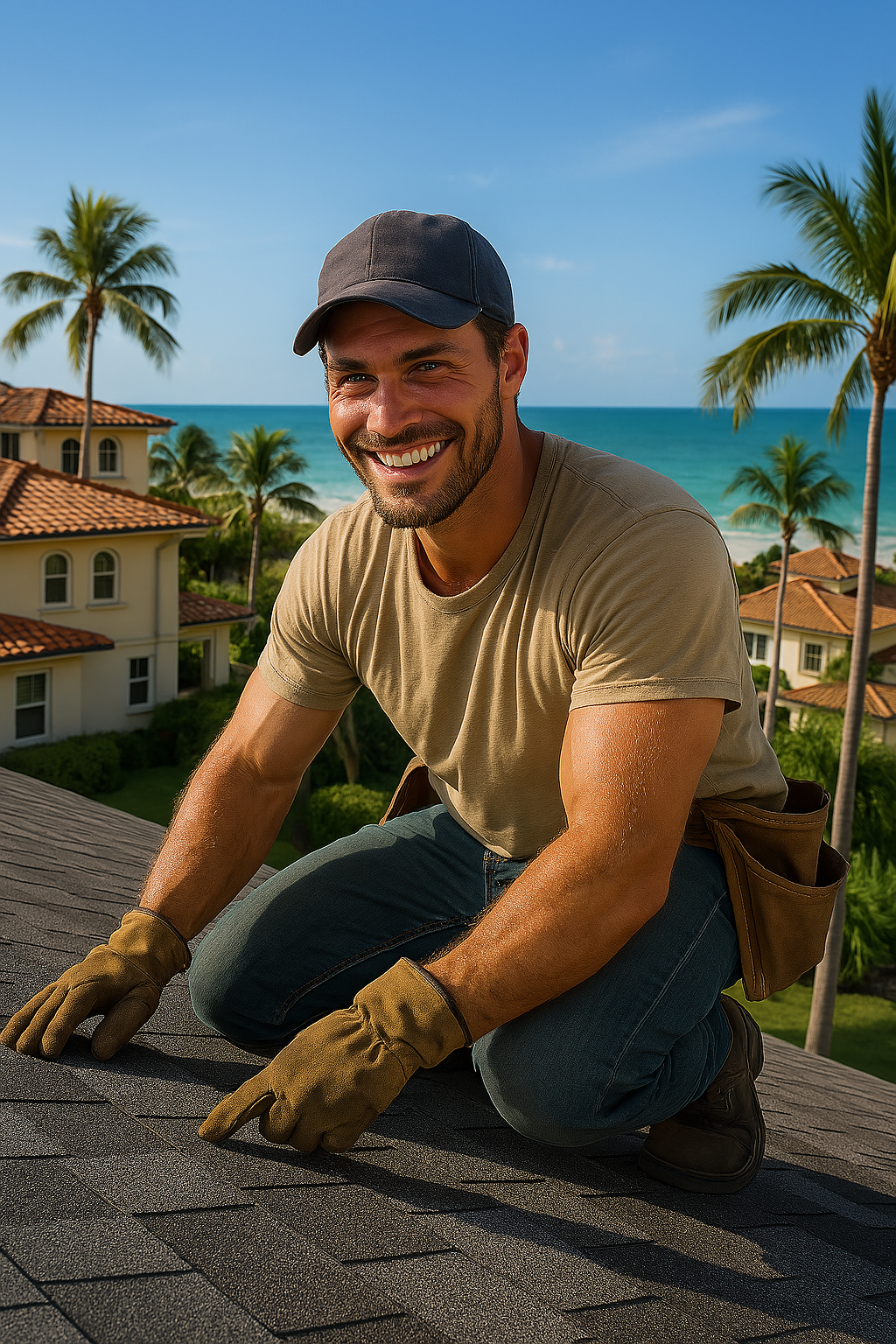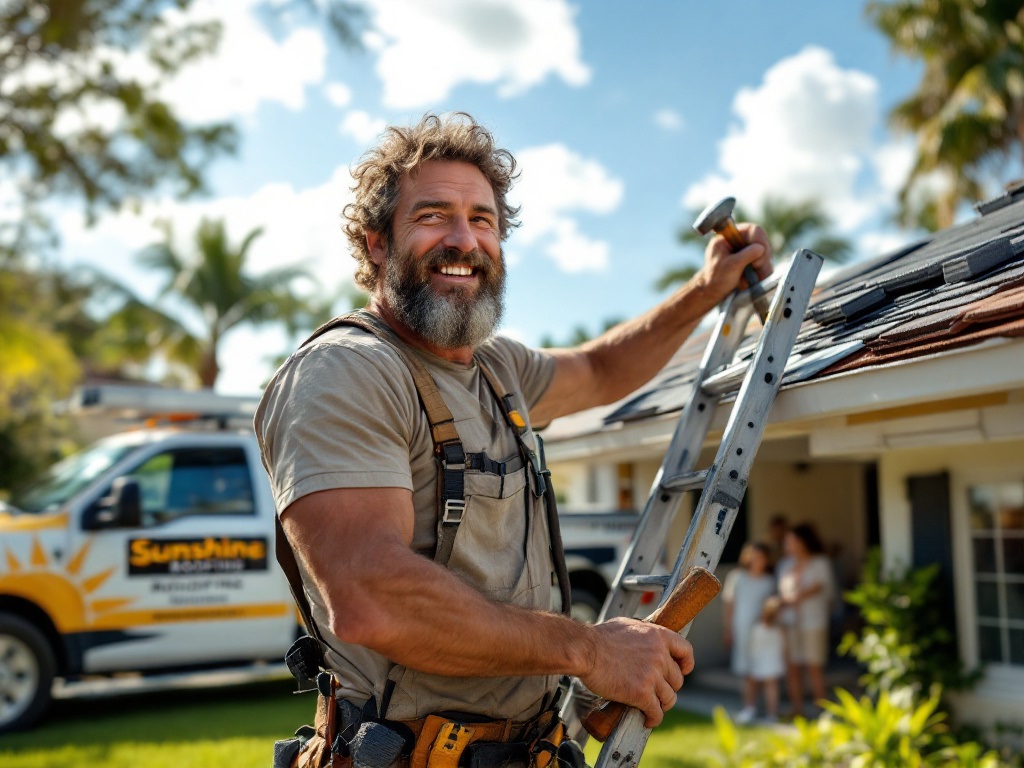
How much does it cost to replace a roof in Tampa Bay? Find out now.
Introduction to Roof Replacement Costs in Tampa Bay
 Understanding the cost to replace a roof in Tampa Bay requires evaluating local factors like material availability, labor rates, and climate challenges. Homeowners often face expenses ranging from $8,000 to $30,000+, depending on roof size, material choice, and structural complexity. Tampa Bay’s humid subtropical climate accelerates wear and tear, making timely replacements critical to avoid costly water damage or energy inefficiencies.
Understanding the cost to replace a roof in Tampa Bay requires evaluating local factors like material availability, labor rates, and climate challenges. Homeowners often face expenses ranging from $8,000 to $30,000+, depending on roof size, material choice, and structural complexity. Tampa Bay’s humid subtropical climate accelerates wear and tear, making timely replacements critical to avoid costly water damage or energy inefficiencies.
Material selection plays a significant role in budgeting for a roof replacement. Asphalt shingles dominate the market due to their affordability, but metal and tile options offer longer lifespans despite higher upfront costs. Labor accounts for 40-60% of the total expense, with Tampa Bay contractors charging $3–$7 per square foot. Always request itemized quotes to compare line items like underlayment, flashing, and disposal fees.
Permits and inspections add another layer to Tampa Bay’s roof replacement costs. Hillsborough and Pinellas counties enforce strict building codes to meet hurricane-resistant standards, which may require reinforced materials. Budget an additional $500–$2,000 for permits, depending on your home’s location and roof design. Proactive planning and working with licensed contractors ensure compliance while avoiding fines or project delays.
Key Cost Drivers in Tampa Bay
- Material durability against high humidity and salt air
- Labor shortages during peak hurricane seasons
- Code upgrades for wind mitigation
Roof replacements in Tampa Bay often uncover hidden issues like rotten decking or inadequate ventilation, which can inflate budgets by 15–25%. Insurance may cover storm-related damage, but standard policies exclude wear and tear. Schedule a pre-inspection to identify these risks early and discuss financing options like FHA Title I loans or contractor payment plans.
Timing your project can also impact the cost to replace a roof. Demand spikes after summer storms, leading to higher labor rates and material shortages. Winter and spring often offer better pricing and faster turnaround times. Compare seasonal promotions from local suppliers and contractors to maximize savings while ensuring your home stays protected year-round.
Key Factors Influencing the Cost to Replace a Roof
The cost to replace a roof in Tampa Bay varies widely based on material selection, labor rates, and roof complexity. Asphalt shingles average $4–$8 per square foot, while metal roofs range from $9–$18. Steep-sloped roofs or homes with multiple dormers increase labor time by 25–40%, raising total costs. Tampa Bay’s stringent building codes also require permits and inspections, adding $800–$2,500 to budgets.
Roof size and accessibility play pivotal roles. A 2,000-square-foot roof typically costs $10,000–$25,000, but homes with limited access (e.g., narrow lots or high elevations) may incur 10–15% surcharges for equipment setup. Tear-off fees for old materials—especially tile or slate—add $1–$5 per square foot. Recycling debris is cheaper in Tampa Bay, with landfills charging $150–$300 per ton versus $50–$100 for recycling centers.
Market trends also impact pricing. Post-hurricane demand spikes often inflate labor rates by 20–30% in Tampa Bay. Supply chain disruptions for imported materials like clay tiles or synthetic underlayment can delay projects and raise costs. Locking in quotes during off-peak seasons (January–April) helps homeowners avoid premium pricing.
Budgeting for Tampa Bay Roof Replacements
- Material durability vs. upfront cost trade-offs
- Permit timelines in Hillsborough vs. Pinellas counties
- Insurance deductibles for storm-related replacements
Hidden structural issues, like rotting decking or outdated ventilation, emerge in 30% of Tampa Bay roof replacements. Contractors charge $75–$150 per sheet for plywood repairs, adding $1,000–$3,000 to projects. Opt for a pre-replacement inspection to identify these issues early. Some Tampa Bay roofers offer financing plans to spread costs over 12–60 months, easing upfront burdens.
Energy-efficient upgrades can offset long-term expenses. Installing radiant barriers or solar-compatible roofing during a replacement may qualify for Tampa Bay-specific rebates. For example, Duke Energy offers $0.10–$0.30 per watt for solar-ready roofs. These investments reduce the lifetime cost to replace a roof while enhancing home value in Tampa Bay’s competitive real estate market.
Tampa Bay Roofing Material Breakdown: Pros, Cons, and Prices
Selecting the right roofing material in Tampa Bay involves balancing durability, aesthetics, and the overall cost to replace a roof. Asphalt shingles remain popular due to their affordability ($4–$8 per square foot) and quick installation, but they may require more frequent replacements in Tampa Bay’s storm-prone climate. Metal roofing, priced between $9–$18 per square foot, offers superior wind resistance and a 50-year lifespan, making it a cost-effective long-term solution for hurricane seasons.
Tile roofs, though aesthetically pleasing and durable, come with higher upfront costs ($10–$25 per square foot) and require reinforced framing due to their weight. Flat roofs, common in commercial properties, use materials like TPO or EPDM ($6–$12 per square foot) but face drainage challenges during Tampa Bay’s heavy rains. Homeowners should prioritize materials with high wind ratings (Class 4 impact resistance) and algae-resistant coatings to combat humidity and salt air corrosion.
Permit requirements and labor expertise also influence material costs. For example, installing clay tiles in Tampa Bay may require specialized contractors, adding 15–20% to labor fees. Always verify local building codes, as Hillsborough and Pinellas counties enforce strict standards for wind uplift and waterproofing. Investing in quality materials reduces the lifetime cost to replace a roof by minimizing repair needs.
Comparing Popular Roofing Materials in Tampa Bay
- Asphalt Shingles: Low cost, moderate durability (15–20 years), prone to wind damage
- Metal Panels: High upfront cost, 50+ year lifespan, excellent storm resistance
- Concrete Tile: Heavyweight, 40–50 year lifespan, requires structural upgrades
Hidden expenses, such as underlayment upgrades or ventilation system adjustments, can add $1,500–$4,000 to the total cost to replace a roof in Tampa Bay. For instance, synthetic underlayment improves moisture resistance but costs 30% more than traditional felt. Energy-efficient options like cool roofs may qualify for local rebates, offsetting initial investments through lower cooling bills.
Seasonal demand fluctuations also affect material availability and pricing. Post-hurricane repairs often lead to shortages, delaying projects and increasing costs. Schedule replacements during Tampa Bay’s drier months (November–April) to secure competitive rates. Partner with contractors certified by manufacturers like GAF or Owens Corning to ensure warranties remain valid under Florida’s harsh climate conditions.
Asphalt Shingles in Tampa Bay: Affordable but Climate-Tested?
 Asphalt shingles are the most common choice for Tampa Bay homeowners due to their budget-friendly pricing ($4–$8 per square foot). However, the region’s extreme weather raises questions about their longevity. Standard 3-tab shingles may last 10–15 years here, compared to 20+ years in milder climates, due to UV exposure and wind uplift during hurricanes. Upgrading to architectural shingles ($6–$10 per square foot) improves durability with a 30-year lifespan and 130 mph wind ratings.
Asphalt shingles are the most common choice for Tampa Bay homeowners due to their budget-friendly pricing ($4–$8 per square foot). However, the region’s extreme weather raises questions about their longevity. Standard 3-tab shingles may last 10–15 years here, compared to 20+ years in milder climates, due to UV exposure and wind uplift during hurricanes. Upgrading to architectural shingles ($6–$10 per square foot) improves durability with a 30-year lifespan and 130 mph wind ratings.
Moisture resistance is another critical factor. Tampa Bay’s humidity accelerates algae growth, leading to unsightly black streaks. Algae-resistant shingles with copper granules add $100–$300 to the total cost to replace a roof but preserve curb appeal. Additionally, using high-temperature asphalt adhesives prevents shingles from loosening during summer heatwaves, a common issue in Florida.
Insurance implications also matter. Some Tampa Bay insurers offer discounts for impact-resistant shingles rated Class 3 or 4. While these shingles cost 20–30% more, they reduce the likelihood of storm-related claims. Always verify compatibility with local building codes, as outdated shingle types may not meet current wind mitigation requirements, risking permit denials.
Pros and Cons of Asphalt Shingles in Tampa Bay
- Pros: Low upfront cost, wide variety of styles, easy installation
- Cons: Shorter lifespan in extreme weather, frequent maintenance needs
- Best For: Budget-conscious homeowners planning to sell within 10–15 years
Post-installation maintenance is crucial for maximizing asphalt shingle longevity. Biannual inspections for cracked or missing shingles can prevent leaks, especially after Tampa Bay’s summer storms. Gutter cleaning and trimming overhanging branches reduce debris buildup, which traps moisture and accelerates wear. Consider adding a reflective coating to lower attic temperatures and extend shingle life.
While asphalt shingles are affordable initially, their shorter replacement cycle may increase the lifetime cost to replace a roof compared to metal or tile. For long-term residents, investing in premium materials often yields better ROI. However, for those prioritizing immediate savings, asphalt remains a viable option when paired with proactive maintenance and climate-specific upgrades.
Metal Roofing Costs: Long-Term Investment for Tampa Bay Homes
Metal roofing is gaining popularity in Tampa Bay for its resilience against hurricanes and extreme heat. With an average cost of $9–$18 per square foot, it’s a significant upfront investment but offers a 50+ year lifespan—triple that of asphalt shingles. Standing seam metal roofs, priced at $12–$18 per square foot, provide superior wind resistance (up to 160 mph), aligning with Tampa Bay’s strict building codes for storm-prone areas.
Energy efficiency is another advantage. Metal roofs reflect sunlight, reducing attic temperatures by 15–20°F and lowering cooling costs by 10–25%. This is particularly valuable in Tampa Bay, where summer temperatures regularly exceed 90°F. Some homeowners qualify for energy tax credits or local utility rebates, offsetting the initial cost to replace a roof. Additionally, metal is fire-resistant and impervious to termites, common concerns in Florida.
Installation complexity affects pricing. Metal panels require specialized contractors, which can add 20–30% to labor costs compared to asphalt. Corrosion-resistant coatings are essential for coastal Tampa Bay homes exposed to salt air, adding $1–$3 per square foot. Despite these costs, metal’s durability often results in lower insurance premiums, making it a financially sound choice over time.
Key Considerations for Metal Roofs in Tampa Bay
- Choose aluminum or galvanized steel for coastal corrosion resistance
- Ensure proper attic ventilation to prevent condensation buildup
- Verify contractor certification from manufacturers like DECRA or Met-Tile
Noise during rainstorms is a common concern, but proper insulation with spray foam or dense plywood sheathing mitigates this issue. Metal roofs also support solar panel installations without penetrations, preserving warranties. For Tampa Bay homeowners planning to stay long-term, the higher initial cost to replace a roof with metal is justified by decades of minimal maintenance and storm protection.
Supply chain delays for imported metals can occasionally inflate costs, especially post-hurricane. Lock in material prices early and schedule installations during off-peak seasons (spring or fall) to avoid premiums. Many Tampa Bay contractors offer financing options, spreading the investment over 5–10 years while immediately benefiting from increased home value and energy savings.
Tile Roof Replacements: Balancing Aesthetics and Tampa Bay Weather
Tile roofs are a hallmark of Tampa Bay’s architectural charm, offering Mediterranean or Spanish-style aesthetics that complement the region’s coastal vibe. However, their performance in Florida’s climate comes with trade-offs. Clay and concrete tiles, priced between $10–$25 per square foot, provide exceptional durability against hurricanes and UV rays, but their weight (up to 1,000 lbs per square) often requires costly structural reinforcements. Tampa Bay homeowners must balance visual appeal with the added cost to replace a roof that meets local wind codes.
Concrete tiles are more affordable than clay, averaging $10–$15 per square foot, but both materials demand specialized installation. Tampa Bay’s humidity and salt air can degrade low-quality tiles, leading to cracking or efflorescence. Opt for tiles with weather-resistant coatings to minimize maintenance. Labor costs for tile installations run 20–30% higher than asphalt due to the skill required, adding $4–$7 per square foot to the total cost to replace a roof.
Permitting is another critical factor. Tampa Bay counties require engineering assessments for tile roofs to ensure homes can support their weight. Reinforcing trusses or decking adds $2,000–$6,000 to projects, but it’s essential for compliance. Tile roofs also excel in energy efficiency, reflecting heat and reducing cooling costs by 10–20%—a key advantage in Florida’s sweltering summers. However, their fragility during foot traffic or debris impact may increase long-term repair expenses.
Tile Roof Considerations for Tampa Bay Homes
- High wind resistance (up to 150 mph) but requires professional installation
- Susceptible to cracking from hail or fallen branches
- Long lifespan (40–50 years) offsets higher upfront costs
Post-installation maintenance is vital for preserving tile roofs in Tampa Bay. Biannual inspections for cracked or displaced tiles can prevent water intrusion during heavy rains. Pressure washing to remove algae or salt residue should be done cautiously to avoid damaging the surface. Many Tampa Bay contractors offer maintenance packages, which cost $200–$500 annually but extend the roof’s lifespan and protect your investment.
Insurance premiums for tile roofs in Tampa Bay are often lower due to their storm resilience, but claims may require documentation of compliance with current building codes. Financing options, such as home equity loans or contractor partnerships, help manage the initial cost to replace a roof. While tile systems demand a higher budget, their blend of aesthetics and durability makes them a strategic choice for Tampa Bay homeowners prioritizing long-term value.
Flat Roof Replacement Costs: Challenges Specific to Tampa Bay
Flat roofs are common in Tampa Bay’s commercial buildings and modern homes, but their design poses unique challenges in Florida’s climate. Replacement costs range from $6–$12 per square foot, depending on materials like TPO, EPDM, or modified bitumen. Standing water from heavy rains is a persistent issue, requiring precise slope adjustments and drainage systems. Tampa Bay contractors often recommend tapered insulation ($1–$3 per square foot) to redirect water and prevent ponding, which accelerates membrane deterioration.
UV exposure and heat are major concerns. Reflective coatings, such as silicone or acrylic, add $1.50–$4 per square foot but extend the roof’s lifespan by shielding against Tampa Bay’s intense sunlight. Hurricane winds can lift poorly sealed edges, so adherence to Florida’s building code (e.g., ASTM D4637 for fastener strength) is non-negotiable. Labor costs account for 50–60% of flat roof replacements due to the technical expertise needed for seamless installations.
Permitting fees in Tampa Bay add $800–$1,500 to flat roof projects, with inspections focusing on drainage efficiency and wind uplift resistance. Homeowners associations (HOAs) may enforce aesthetic guidelines, limiting material choices or colors. Despite higher maintenance needs, flat roofs offer usable space for solar panels or rooftop gardens, which can offset the cost to replace a roof through energy savings or increased property value.
Flat Roofing Challenges in Tampa Bay
- Drainage failures leading to leaks and structural damage
- Material degradation from constant UV exposure
- Code requirements for wind resistance (130+ mph)
Proactive repairs are critical for flat roofs. Annual inspections after Tampa Bay’s rainy season (June–September) can identify blisters, cracks, or seam separations early. Emergency repairs for storm damage cost 30–50% more during peak seasons, so schedule replacements in spring or fall. Many Tampa Bay roofers offer 10–20 year warranties on flat roof materials, contingent on regular maintenance.
Energy-efficient upgrades, like cool roofing membranes, qualify for rebates from Tampa Electric or Duke Energy, reducing the net cost to replace a roof. While flat systems require more frequent upkeep than sloped roofs, their modern appeal and functional space make them a practical choice for Tampa Bay properties—provided homeowners budget for long-term maintenance and climate-specific upgrades.
Labor Costs for Roofing Contractors in Tampa Bay
 Labor accounts for 40–60% of the total cost to replace a roof in Tampa Bay, with rates varying by project complexity and material type. Contractors typically charge $3–$7 per square foot, but steep slopes or intricate designs (e.g., multiple valleys or skylights) can push rates to $10+ per square foot. Tampa Bay’s skilled labor shortage during peak hurricane seasons also inflates prices, as demand outstrips supply from June to November.
Labor accounts for 40–60% of the total cost to replace a roof in Tampa Bay, with rates varying by project complexity and material type. Contractors typically charge $3–$7 per square foot, but steep slopes or intricate designs (e.g., multiple valleys or skylights) can push rates to $10+ per square foot. Tampa Bay’s skilled labor shortage during peak hurricane seasons also inflates prices, as demand outstrips supply from June to November.
Experience and certifications impact pricing. Master-certified contractors, such as those endorsed by GAF or CertainTeed, charge 15–25% more but offer enhanced warranties and compliance with Florida’s building codes. Disposal fees for old materials add $1–$3 per square foot, though some Tampa Bay crews include this in labor quotes. Always verify licensing (CBC 1259865 or RCATB membership) to avoid uninsured subcontractors.
Timing your project can yield savings. Off-peak seasons (December–April) often feature discounted labor rates due to reduced demand. However, sudden storms can disrupt schedules—factor in a 10–15% buffer for potential delays. Tampa Bay homeowners should request itemized bids to compare labor vs. material costs and ensure no hidden fees for equipment rentals or safety harness setups.
Factors Affecting Tampa Bay Roofing Labor Costs
- Roof pitch and accessibility (e.g., multi-story homes)
- Specialized skills for metal or tile installations
- Permit acquisition and inspection coordination
Unexpected structural repairs, like replacing rotted decking, often arise mid-project. Contractors bill $75–$150 per hour for these extras, so include a 10% contingency in your budget. Some Tampa Bay companies offer financing through partners like Hearth or GreenSky, spreading labor costs over 12–60 months. Always confirm workers’ compensation coverage to avoid liability for on-site injuries.
Post-installation clean-up is typically included in labor quotes, but verify this to prevent surprise charges. Tampa Bay’s competitive roofing market means comparing 3–5 bids can save $1,000–$3,000 on labor. Prioritize contractors with local references and storm repair expertise, as they’re better equipped to navigate the region’s unique climate challenges and code requirements.
Permit Fees and Regulations: Tampa Bay’s Legal Requirements
Navigating Tampa Bay’s permit requirements is critical when budgeting the cost to replace a roof. Hillsborough and Pinellas counties mandate permits for all roof replacements, with fees ranging from $150 to $800 based on project scope. These permits ensure compliance with Florida Building Code standards, including wind uplift resistance (110+ mph) and impact-resistant materials in hurricane-prone zones. Skipping permits risks fines up to $5,000 and complications during home sales.
Roofing permits in Tampa Bay require detailed documentation, such as material specifications, contractor licenses, and engineering reports for tile or metal systems. Inspections occur at three stages: decking, underlayment, and final approval. Delays in inspections can push project timelines by 1–2 weeks, especially during peak seasons. Some municipalities, like St. Petersburg, enforce stricter energy efficiency standards, requiring reflective coatings or solar-ready designs.
Homeowners associations (HOAs) add another layer of regulation. Many Tampa Bay communities restrict material colors, profiles, or brands, which can increase the cost to replace a roof by 5–15% for premium options. Always submit HOA applications early—approval can take 2–4 weeks. Working with contractors familiar with local codes streamlines the process, avoiding costly redesigns or post-installation penalties.
Tampa Bay Roofing Permit Essentials
- Basic permit fees: $150–$800 (varies by county)
- Wind mitigation documentation for insurance discounts
- HOA approval timelines and design restrictions
Unpermitted work voids most roofing warranties and insurance policies. For example, Tampa Bay insurers like Citizens may deny storm damage claims if roofs lack proper permits. Budget an extra $500–$1,000 for potential code upgrades, such as hurricane straps or reinforced trusses. Reputable contractors handle permit applications, but always verify their license (e.g., Florida CBC 1259865) to avoid scams.
Digital permitting systems in Tampa Bay (e.g., Pinellas County’s iMS) expedite approvals, reducing processing times from weeks to days. However, complex projects in historic districts, like Tampa’s Ybor City, require additional reviews. Factor in 10–20% extra time for these cases. Permitting isn’t just a legal step—it’s a safeguard ensuring your roof meets Tampa Bay’s rigorous safety and quality standards.
How Tampa Bay’s Hurricane Seasons Impact Roofing Expenses
Tampa Bay’s hurricane season (June–November) directly influences the cost to replace a roof through supply shortages, labor spikes, and emergency premiums. Post-storm demand can surge by 300%, causing contractors to prioritize urgent repairs over replacements. Material prices for impact-resistant shingles or metal panels rise 15–25% during this period, while labor rates jump $2–$4 per square foot due to overtime pay and hazardous working conditions.
Insurance deductibles also play a role. Most Tampa Bay policies have hurricane-specific deductibles of 2–5% of home value, which can exceed $5,000 for high-risk coastal homes. Proactive replacements before June may qualify for lower deductibles under “preventative maintenance” clauses. Additionally, Florida’s My Safe Florida Home program offers grants up to $10,000 for wind mitigation upgrades, reducing out-of-pocket costs for eligible homeowners.
Code upgrades mandated after major storms further inflate expenses. For example, following Hurricane Irma, Tampa Bay updated requirements for sealed decking and secondary water barriers, adding $1–$3 per square foot to replacements. Storage fees for materials during delays (common amid supply chain disruptions) can also add $200–$500 monthly—a hidden cost many overlook.
Hurricane-Related Cost Surges in Tampa Bay
- Emergency tarping fees: $500–$2,000 (not covered by insurance)
- Post-storm material shortages (30–60 day delays)
- Increased dumpster rentals for debris removal
Pre-hurricane inspections are a wise investment. Tampa Bay roofers charge $150–$300 to assess vulnerabilities like loose flashing or worn sealants. Addressing these early avoids post-storm emergency replacements, which cost 40–60% more. Consider storm-resistant materials like Class 4 shingles or metal roofs, even if pricier upfront—they often qualify for insurance discounts and withstand multiple hurricane seasons.
Financing options help manage seasonal spikes. Tampa Bay credit unions like GTE Financial offer home improvement loans with 5–7% APR, spreading costs over 5–10 years. Schedule replacements in spring (March–May) to lock in pre-hurricane pricing and ensure your roof is storm-ready. While hurricane seasons elevate short-term expenses, strategic planning minimizes the lifetime cost to replace a roof in Tampa Bay.
Hidden Costs of Roof Replacement in Tampa Bay (2024 Guide)
Beyond material and labor fees, Tampa Bay homeowners face hidden costs during roof replacements. Structural repairs, like replacing rotted decking ($75–$150 per sheet), add $1,500–$5,000 to projects. Older homes often lack modern ventilation, requiring $800–$2,500 for updated soffit vents or ridge vents to meet code and prevent moisture buildup—a critical upgrade in Tampa Bay’s humid climate.
Disposal fees are another overlooked expense. Tearing off a 2,000-square-foot asphalt roof generates 4–6 tons of debris, costing $300–$800 for landfill fees. Recycling is cheaper ($100–$300), but not all materials qualify. Permit revisions due to mid-project changes (e.g., switching shingle brands) incur $50–$200 fees. Always allocate a 10–15% contingency fund to cover these surprises.
Seasonal factors also inflate costs. Summer heatwaves require temporary shading or cooling setups for workers, adding $200–$500 daily. Winter projects may need weather delays factored into contracts. Tampa Bay’s HOA fines for prolonged construction (e.g., $100–$500 weekly) further strain budgets if timelines overrun.
Common Hidden Costs in Tampa Bay
- Emergency tarping after unexpected rain: $300–$800
- Upgraded flashing for skylights or chimneys: $15–$35 per linear foot
- Landscaping repairs post-construction: $500–$1,500
Insurance audits can reveal coverage gaps. For instance, Tampa Bay policies often exclude “wear and tear” damage, leaving homeowners responsible for underlying issues discovered during replacements. A pre-replacement inspection ($250–$500) identifies these risks early. Some contractors offer “tear-off warranties” covering decking repairs—ask about these to avoid surprise bills.
Energy efficiency upgrades, while optional, can offset hidden costs over time. Installing radiant barriers ($0.50–$1.50 per square foot) during a replacement cuts cooling costs by 5–10%, saving Tampa Bay homeowners $200–$500 annually. Discuss these add-ons during initial quotes to bundle labor and maximize value from the cost to replace a roof.
Comparing Tampa Bay Roofing Costs to National Averages
The average cost to replace a roof in Tampa Bay ranges 10–25% higher than national averages due to climate-specific requirements and labor premiums. Nationally, asphalt shingle roofs average $5–$7 per square foot, but Tampa Bay homeowners pay $6–$9 for impact-resistant upgrades. Metal roofs, which cost $10–$14 per square foot nationally, rise to $12–$18 locally for corrosion-resistant coatings and hurricane strapping.
Labor costs also skew higher. While national roofing labor averages $3–$5 per square foot, Tampa Bay contractors charge $4–$7 due to stringent building codes and insurance requirements. Permit fees add another layer—$800–$2,000 locally versus $500–$1,500 nationally—to meet Florida’s wind mitigation standards. These investments, though costly upfront, reduce long-term storm damage risks unique to Tampa Bay.
Material availability further impacts pricing. Clay tiles, common in Tampa Bay’s Mediterranean-style homes, cost 15–20% more than in landlocked states due to import tariffs and specialized labor. However, energy-efficient materials like cool roofs offer comparable pricing to national averages, with Tampa Bay homeowners often qualifying for additional state rebates to offset expenses.
Key Tampa Bay vs. National Cost Differences
- Higher wind-rated material requirements
- Elevated labor rates due to hurricane codes
- Coastal corrosion treatments (+8–12%)
Insurance premiums also distort comparisons. Tampa Bay’s average annual homeowners insurance is $3,600—double the national average—which influences financing costs for roof replacements. However, Florida’s My Safe Florida Home program provides grants up to $10,000 for upgrades, narrowing the gap for eligible residents. Always factor in Tampa Bay’s unique climate risks when evaluating “average” costs.
Despite higher initial costs, Tampa Bay roofs often outlast national averages due to climate-optimized materials. A 30-year asphalt roof here may last 20 years, but metal or tile systems can exceed 50 years with proper maintenance. This longevity partially offsets the elevated cost to replace a roof, making premium materials a strategic choice for long-term residents.
Financing Options for Roof Replacements in Tampa Bay
 Financing a roof replacement in Tampa Bay requires navigating options tailored to Florida’s high insurance and material costs. Home equity loans (HELOCs) offer rates as low as 4–6% APR, using your property’s equity to fund projects. Contractor financing plans, like those from Tampa Bay Roofing or Empire Roofing, provide 0–5% interest for 12–24 months, though terms vary by credit score.
Financing a roof replacement in Tampa Bay requires navigating options tailored to Florida’s high insurance and material costs. Home equity loans (HELOCs) offer rates as low as 4–6% APR, using your property’s equity to fund projects. Contractor financing plans, like those from Tampa Bay Roofing or Empire Roofing, provide 0–5% interest for 12–24 months, though terms vary by credit score.
Government programs can ease the burden. The FHA Title I Loan Program allows Tampa Bay homeowners to borrow up to $25,000 for roof replacements without equity, with fixed rates around 6–8%. Florida’s Solar and Energy Loan Fund (SELF) offers 3–6% interest loans for energy-efficient upgrades like cool roofs, which qualify for additional utility rebates in Tampa Bay.
Insurance endorsements are another avenue. Adding a “roof replacement cost” rider to your policy increases premiums by 10–15% but guarantees full coverage for storm damage. For seniors, Tampa Bay’s Property Assessed Clean Energy (PACE) program defers payments until the home sells, though interest accrues at 7–9% annually.
Top Financing Strategies in Tampa Bay
- HELOCs for low-interest, long-term repayment
- Contractor 0% APR promotions (6–18 months)
- SELF loans for energy-efficient materials
Credit unions like Grow Financial and MidFlorida Credit Union offer competitive personal loans (6–10% APR) for Tampa Bay homeowners with fair credit. Avoid high-interest credit cards—rates of 18–25% APR can double the total cost to replace a roof. Always verify contractor affiliations with lenders to avoid scams.
Emergency funding is available post-storm through FEMA’s Disaster Assistance Program, but approval requires proof of uninsured damage. Tampa Bay homeowners should maintain a $1,000–$5,000 emergency fund for deductibles. Combining financing with insurance payouts and rebates minimizes out-of-pocket costs, making the cost to replace a roof more manageable in Tampa Bay’s high-risk climate.
Insurance Claims and Roof Replacement: Tampa Bay Policies
Navigating insurance claims for roof replacements in Tampa Bay requires understanding Florida’s unique policy landscape. Most insurers, including Citizens and Tower Hill, enforce a “25% rule,” denying full replacement coverage if over 25% of the roof is damaged unless it’s brought up to current code. This can add $5,000–$15,000 to out-of-pocket costs for older Tampa Bay homes.
Wind mitigation inspections are critical for discounts. Tampa Bay homeowners can save 20–40% on premiums by providing proof of hurricane straps, impact-resistant shingles, or secondary water barriers. However, claims for wear-and-tear damage (e.g., algae growth) are typically denied, emphasizing the need for routine maintenance to preserve coverage eligibility.
Public adjusters charge 10–20% of claim payouts but maximize settlements in complex cases, like hurricane damage across multiple properties. Tampa Bay’s 2022 Senate Bill 76 limits attorney fees in roofing disputes, making thorough documentation of storm damage essential. Always photograph pre-existing conditions and obtain contractor estimates before filing claims.
Insurance Tips for Tampa Bay Homeowners
- Schedule wind mitigation inspections every 5 years
- Upgrade to Class 4 shingles for premium discounts
- Review policy exclusions for “cosmetic” vs. “functional” damage
Depreciation clauses significantly affect payouts. For example, a 15-year-old asphalt roof in Tampa Bay may only receive 30–50% of its replacement value from insurers. Opting for replacement cost value (RCV) over actual cash value (ACV) policies ensures fuller coverage, albeit with higher premiums. Document all communications and keep receipts for code upgrades.
Post-claim timelines are strict. Tampa Bay insurers require damage reports within 30–60 days of storms. Delays risk denied claims, even if hidden issues emerge later. Partner with contractors experienced in insurance workflows—they’ll handle supplement requests and negotiate with adjusters, reducing the stress of managing the cost to replace a roof after disasters.
Choosing a Tampa Bay Roofing Contractor: Red Flags to Avoid
Selecting a reputable contractor is critical to managing the cost to replace a roof in Tampa Bay while ensuring quality workmanship. Unlicensed or inexperienced roofers often underbid projects by 20–40%, but cut corners that lead to code violations or premature failures. Always verify Florida state licensing (CBC or CGC license numbers) and Tampa Bay-specific certifications, such as GAF Master Elite or Owens Corning Preferred Contractor status.
Be wary of contractors who demand full payment upfront or refuse to provide written contracts. Tampa Bay law requires detailed contracts outlining materials, timelines, and warranty terms. High-pressure sales tactics, like “storm-chasing” offers post-hurricane, often signal scams. Legitimate contractors carry workers’ compensation and liability insurance—request certificates and confirm they’re current with local providers like Citizens Property Insurance.
Local references are non-negotiable. A trustworthy Tampa Bay roofer will share recent project addresses in your neighborhood and have verifiable reviews on platforms like Google or the Better Business Bureau. Avoid out-of-town crews lacking knowledge of regional codes, such as Tampa’s historic district requirements or Pinellas County’s coastal wind uplift standards.
Top Red Flags When Hiring Tampa Bay Roofers
- No physical office or local phone number
- Vague or incomplete written estimates
- Pressure to sign contracts immediately
Unmarked trucks and generic email addresses (e.g., Gmail) often indicate unestablished operations. Tampa Bay homeowners should also avoid contractors who won’t obtain permits—this shifts liability to you if work fails inspections. Ask for proof of recent permits pulled in Hillsborough or Pasco counties to confirm compliance expertise.
Payment schedules should align with project milestones. Reputable Tampa Bay roofers typically require 10–30% upfront, with the balance due after final inspection. Financing through third-party lenders like Hearth or GreenSky adds accountability, as funds are released only upon verified completion. Always prioritize quality over the lowest bid to avoid doubling the cost to replace a roof due to repairs.
Energy-Efficient Roofing: Does It Lower Costs in Tampa Bay?
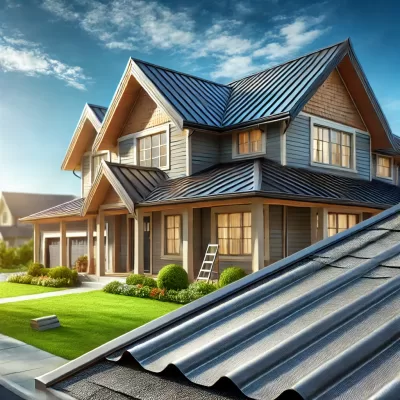 Energy-efficient roofing can significantly reduce the long-term cost to replace a roof in Tampa Bay by lowering cooling expenses. Cool roofing materials, like reflective metal or TPO membranes, deflect sunlight and reduce attic temperatures by 10–25°F. This translates to 10–30% savings on summer energy bills—a major advantage in Tampa Bay’s sweltering climate. However, these materials often cost 15–30% more upfront than standard asphalt shingles.
Energy-efficient roofing can significantly reduce the long-term cost to replace a roof in Tampa Bay by lowering cooling expenses. Cool roofing materials, like reflective metal or TPO membranes, deflect sunlight and reduce attic temperatures by 10–25°F. This translates to 10–30% savings on summer energy bills—a major advantage in Tampa Bay’s sweltering climate. However, these materials often cost 15–30% more upfront than standard asphalt shingles.
Solar-ready roofs are another sustainable option. Installing mounting systems during a replacement ($500–$2,000 extra) future-proofs your home for solar panels, which Tampa Electric incentivizes with rebates up to $2,000. Green roofs with vegetative layers are rare in Tampa Bay due to hurricane risks but offer stormwater management benefits. Always balance energy savings with durability—clay tiles provide natural insulation but require structural upgrades.
Local incentives improve affordability. The Tampa Bay area participates in federal tax credits for energy-efficient upgrades, covering 26–30% of material costs through 2032. Florida’s PACE financing also allows deferred payments for qualifying projects. While initial costs are higher, energy-efficient roofs can pay for themselves in 8–12 years through utility savings and increased home resale value.
Benefits of Energy-Efficient Roofs in Tampa Bay
- Reduced AC usage during peak summer months
- Eligibility for tax credits and utility rebates
- Extended roof lifespan due to thermal protection
Proper installation is key to maximizing efficiency. Tampa Bay contractors must follow ENERGY STAR guidelines for reflective materials and ensure airtight sealing around vents. Annual maintenance, like clearing debris from solar panels or reapplying reflective coatings, preserves performance. Homeowners in coastal zones should prioritize corrosion-resistant metals to balance efficiency and storm resilience.
Energy audits ($300–$500) help identify complementary upgrades, such as attic insulation or radiant barriers, that amplify savings. While the cost to replace a roof with premium efficiency features is higher initially, Tampa Bay’s year-round cooling needs make these investments financially viable over time—especially with rising energy prices.
Re-Roofing vs. Full Replacement: Which Saves Tampa Bay Homeowners More?
Re-roofing—installing new shingles over existing layers—costs $3–$5 per square foot in Tampa Bay, roughly half the price of a full replacement. However, Florida building codes prohibit more than two layers, and many older homes already have multiple installations. This short-term fix avoids tear-off fees ($1–$4 per square foot) but masks underlying issues like rotten decking or inadequate ventilation, which can escalate repair costs later.
Full replacements ($6–$18 per square foot) are mandatory if the roof deck is compromised or if upgrading to heavier materials like tile. Tampa Bay’s hurricane codes often require structural reinforcements during replacements, adding $2,000–$8,000 to projects. While pricier upfront, full replacements reset the roof’s lifespan and comply with current wind mitigation standards, potentially lowering insurance premiums by 15–25%.
Consider a roof’s age and storm history. Homes with 15+ year-old roofs in Tampa Bay typically benefit more from full replacements, especially after hurricane damage. Re-roofing suits newer homes (under 10 years) with minor wear, but lenders and insurers may view it as a liability. Always obtain a professional inspection to determine the most cost-effective approach.
When to Choose Re-Roofing vs. Replacement
- Re-Roofing: Limited budget, minimal existing damage, no code violations
- Full Replacement: Storm damage, multiple layers, material upgrades
Re-roofing voids most manufacturer warranties unless the existing underlayment is intact. Tampa Bay contractors often discourage this method for tile or metal systems due to weight concerns. Full replacements allow for modern upgrades like ice-and-water shields or synthetic underlayment, which enhance durability in Florida’s rainy season.
Financing options differ between the two. Tampa Bay’s FHA Title I loans cover replacements but exclude re-roofing. Insurance payouts also favor full replacements after storm damage. While re-roofing offers immediate savings, the long-term cost to replace a roof prematurely often outweighs initial benefits—especially in Tampa Bay’s harsh climate.
How Roof Pitch and Complexity Affect Tampa Bay Replacement Costs
Roof pitch significantly impacts the cost to replace a roof in Tampa Bay, with steep slopes (6:12 or higher) increasing labor fees by 20–40%. Contractors charge $5–$10 per square foot for steep roofs due to safety harness requirements and slower installation times. Low-pitch or flat roofs, while cheaper to install ($4–$8 per square foot), often need specialized waterproofing to handle Tampa Bay’s heavy rains, adding $1–$3 per square foot for membranes or tapered insulation.
Complex designs with multiple valleys, dormers, or skylights further escalate costs. Each additional valley adds $50–$150 per linear foot for precise flashing and underlayment work. Tampa Bay’s historic homes often feature intricate details like turrets or cupolas, requiring custom-cut materials and skilled labor. These elements can raise the total cost to replace a roof by $3,000–$10,000 compared to simpler suburban designs.
Material waste is another factor. Complex roofs generate 10–25% more waste during installation, increasing disposal fees. Tampa Bay landfills charge $150–$300 per ton, making recycling ($50–$100 per ton) a cost-saving alternative. Always request a 3D satellite measurement from contractors to minimize waste and ensure accurate quotes for your roof’s unique geometry.
Key Factors Influencing Roof Replacement Complexity
- Steep slopes requiring specialized equipment
- Multiple penetrations (vents, chimneys, skylights)
- Historic preservation guidelines in neighborhoods like Hyde Park
Unexpected structural issues, such as rotted trusses or sagging decking, often emerge during replacements of complex roofs. Tampa Bay contractors typically charge $75–$150 per hour for repairs, so allocate a 10–15% contingency fund. Permitting fees also rise with complexity—Hillsborough County adds $100–$500 for engineering reviews on non-standard designs.
Seasonal timing affects accessibility. Summer heat makes steep roof work hazardous, while winter winds can delay projects. Schedule replacements in spring or fall to balance safety and cost efficiency. Tampa Bay homeowners should prioritize contractors with OSHA certifications and experience in high-pitch installations to avoid accidents and ensure code compliance.
Tampa Bay’s Top Roofing Materials for Storm Resistance
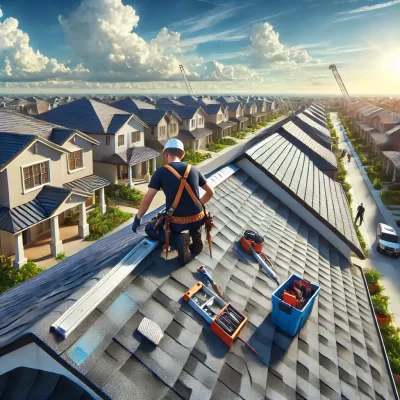 In Tampa Bay’s hurricane-prone climate, storm-resistant roofing materials are essential to minimize long-term replacement costs. Metal roofs lead the market with wind ratings up to 160 mph and impact-resistant coatings, priced at $12–$18 per square foot. Concrete tile ($10–$15 per square foot) offers similar durability but requires reinforced framing to handle its weight—a $3,000–$8,000 upgrade for older Tampa Bay homes.
In Tampa Bay’s hurricane-prone climate, storm-resistant roofing materials are essential to minimize long-term replacement costs. Metal roofs lead the market with wind ratings up to 160 mph and impact-resistant coatings, priced at $12–$18 per square foot. Concrete tile ($10–$15 per square foot) offers similar durability but requires reinforced framing to handle its weight—a $3,000–$8,000 upgrade for older Tampa Bay homes.
Class 4 impact-resistant asphalt shingles ($8–$12 per square foot) mimic traditional aesthetics while withstanding hail and debris. These shingles meet Florida’s strict building codes and often qualify for insurance discounts. TPO membranes ($6–$10 per square foot) dominate flat roofing in commercial properties, providing seamless waterproofing during Tampa Bay’s summer thunderstorms.
Material warranties vary by storm resilience. Metal roofs in Tampa Bay typically come with 30–50 year warranties, while asphalt shingles max out at 25 years. Always verify wind uplift ratings (ASTM D7158) and corrosion resistance for coastal homes. Investing in premium materials reduces the frequency and cost to replace a roof after major storms.
Best Storm-Resistant Materials for Tampa Bay
- Standing seam metal roofs (160 mph wind resistance)
- Class 4 asphalt shingles (UL 2218 impact-rated)
- Reinforced concrete tiles with hurricane clips
Insurance incentives sweeten the deal. Tampa Bay insurers like Citizens offer 10–30% premium discounts for homes with FBC (Florida Building Code)-compliant roofs. Post-storm inspections are faster for these materials, speeding up claims processing. Combine storm-resistant roofs with secondary water barriers ($1–$2 per square foot) to meet Tampa Bay’s enhanced code requirements enacted after Hurricane Irma.
Supply chain delays for imported materials (e.g., Spanish clay tiles) can inflate costs during peak hurricane seasons. Lock in pricing with local suppliers like ABC Supply or Beacon Roofing early. While storm-resistant materials cost 15–40% more upfront, they protect Tampa Bay homeowners from frequent replacements and catastrophic storm damage.
Case Study: Roof Replacement Costs in St. Petersburg vs. Tampa
Roof replacement costs in St. Petersburg and Tampa reflect subtle regional differences. St. Petersburg’s coastal location increases material corrosion risks, pushing homeowners toward pricier aluminum or galvanized steel ($14–$20 per square foot). Tampa’s inland neighborhoods more commonly use asphalt shingles ($6–$10 per square foot), resulting in 10–15% lower average project costs. Both cities enforce Florida’s wind mitigation codes, but permit fees vary—Pinellas County (St. Pete) charges $200–$600, while Hillsborough County (Tampa) fees range $150–$500.
Labor availability also impacts pricing. Tampa’s larger contractor pool creates competitive rates ($4–$7 per square foot), whereas St. Petersburg’s seasonal demand spikes post-storm lead to 20–30% higher labor costs. Historic districts like St. Pete’s Old Northeast often require specialized materials like cedar shakes or slate, adding $5–$15 per square foot compared to Tampa’s suburban developments.
Insurance rates further differentiate the cities. St. Petersburg’s higher hurricane risk results in average annual premiums of $4,200 vs. Tampa’s $3,800. However, St. Pete residents qualify for larger FEMA mitigation grants, offsetting the cost to replace a roof. Both cities share challenges like humidity-driven algae growth, necessitating regular $200–$500 cleanings.
Key Cost Comparisons
- St. Petersburg: Higher material costs, coastal code upgrades
- Tampa: Competitive labor rates, inland storm risk discounts
- Shared: $1,500–$3,000 for mandatory hurricane straps
St. Petersburg’s stricter HOA guidelines often mandate premium materials like barrel tiles, adding $3–$8 per square foot. Tampa’s mixed roofing styles allow more flexibility. Both cities face post-storm price surges, but Tampa’s larger supplier network shortens material delays. Homeowners should obtain quotes from contractors licensed in both counties to compare localized costs.
Long-term savings differ too. St. Petersburg’s salt air reduces asphalt shingle lifespans to 12–18 years vs. Tampa’s 15–25 years. Metal roofs last equally in both cities (50+ years) but require more frequent coating reapplications in coastal zones. Understanding these nuances helps Tampa Bay homeowners budget accurately for their specific location.
DIY Roofing in Tampa Bay: Risks vs. Potential Savings
DIY roofing projects in Tampa Bay might seem appealing for homeowners aiming to reduce the cost to replace a roof, but the risks often outweigh potential savings. Tampa Bay’s stringent building codes require permits, wind-resistant materials, and professional inspections—steps DIYers frequently overlook. Errors in installation, such as improper flashing or inadequate underlayment, can lead to leaks, mold, or even structural damage during hurricane seasons, negating initial savings.
Permitting poses another hurdle. Hillsborough and Pinellas counties mandate detailed plans for roof replacements, including engineering certifications for materials like tile or metal. DIY applicants often face rejections due to non-compliant designs, delaying projects and incurring $100–$500 in resubmission fees. Additionally, contractors receive bulk discounts on materials, which DIY buyers can’t access, raising supply costs by 15–25%.
Safety risks are paramount. Tampa Bay’s high humidity and sudden summer storms make rooftop work hazardous. Falls account for 34% of construction fatalities in Florida, and improper tool use increases injury risks. While DIY may save $3,000–$7,000 upfront, correcting mistakes often doubles the final cost to replace a roof. Homeowners also forfeit manufacturer warranties, which require professional installation.
Key Risks of DIY Roofing in Tampa Bay
- Code violations leading to fines up to $5,000
- Voided warranties on materials and labor
- Increased insurance premiums for unpermitted work
Insurance complications further deter DIY efforts. Most Tampa Bay insurers deny claims for damage stemming from unlicensed work, leaving homeowners liable for repairs. Post-storm inspections may flag DIY roofs as high-risk, raising premiums by 20–30%. For complex tasks like sealing flat roofs or installing hurricane straps, hiring licensed professionals ensures compliance and long-term reliability.
While DIY might cut initial costs, Tampa Bay’s climate demands precision best left to experts. Contractors offer financing plans that spread expenses over time, making professional replacements more accessible. Investing in quality workmanship avoids the hidden costs of DIY errors, ensuring your roof withstands Tampa Bay’s unique challenges.
Warranty Considerations for Tampa Bay Roof Replacements
Warranties are critical when calculating the cost to replace a roof in Tampa Bay, as they protect against premature material failure and installation defects. Most manufacturers offer 20–50 year warranties for asphalt shingles and metal panels, but these often exclude “acts of God” like hurricanes. Tampa Bay homeowners should prioritize warranties with wind uplift coverage (up to 150 mph) and algae resistance, given the region’s humidity and storm frequency.
Workmanship warranties from contractors are equally vital. Reputable Tampa Bay roofers provide 5–10 year warranties covering labor errors, such as improper flashing or ventilation. However, these warranties require annual maintenance, like cleaning debris or inspecting seals, to remain valid. Failure to document maintenance can void coverage, leaving homeowners responsible for repairs after storms.
Climate-specific exclusions are common. For example, clay tile warranties may exclude saltwater corrosion in coastal zones like St. Pete Beach. Always review warranty terms with contractors familiar with Tampa Bay’s building codes. Enhanced warranties, though costing 5–10% more upfront, save thousands long-term by covering hurricane-related repairs.
Top Warranty Tips for Tampa Bay Homeowners
- Opt for non-prorated warranties for full replacement value
- Ensure wind and hail damage are explicitly covered
- Verify contractor warranties include labor and materials
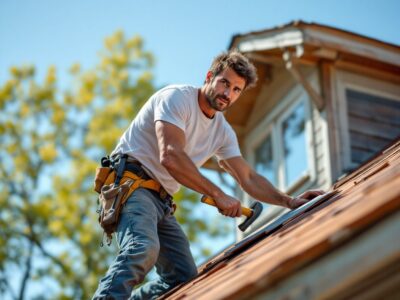 Transferability adds value if selling your home. Tampa Bay’s competitive real estate market favors homes with transferable roof warranties, boosting resale prices by 3–5%. However, warranties tied to specific contractors (not manufacturers) may not transfer, so clarify terms upfront. Always keep copies of warranties and installation receipts for insurance claims.
Transferability adds value if selling your home. Tampa Bay’s competitive real estate market favors homes with transferable roof warranties, boosting resale prices by 3–5%. However, warranties tied to specific contractors (not manufacturers) may not transfer, so clarify terms upfront. Always keep copies of warranties and installation receipts for insurance claims.
Post-storm inspections are essential for warranty compliance. After hurricanes, Tampa Bay homeowners must document damage within 30 days to qualify for repairs. Partnering with manufacturers like GAF or Owens Corning, which have local certified contractors, streamlines claims. While warranties add to the initial cost to replace a roof, they provide peace of mind in Tampa Bay’s high-risk climate.
How Long Does a Roof Replacement Take in Tampa Bay?
The timeline to replace a roof in Tampa Bay typically spans 3–10 days, depending on material choice and weather. Asphalt shingle replacements average 2–5 days, while metal or tile installations take 7–14 days due to complexity. Delays are common during hurricane season (June–November), as contractors prioritize emergency repairs, pushing scheduled projects back by 2–3 weeks.
Permit approvals add 7–14 days to timelines. Tampa Bay counties like Pasco require in-person inspections, which can stall projects if failures occur. Complex roofs with steep pitches or multiple layers extend tear-off and installation phases by 30–50%. Homeowners should also factor in material lead times—clay tiles and specialty metals may take 4–6 weeks to arrive post-order.
Weather disruptions are inevitable. Summer thunderstorms halt work for safety, adding 1–3 days per week. Winter projects face fewer delays but risk morning dew prolonging adhesive curing. Scheduling replacements in spring (March–May) optimizes speed, as contractors have lower backlogs and mild weather prevails.
Factors Impacting Roof Replacement Timelines
- Permit processing speed in your county
- Roof accessibility and structural complexity
- Material availability from local suppliers
Unexpected structural repairs, like replacing rotted decking, can add 2–5 days. Tampa Bay contractors charge $75–$150 hourly for these extras, so include buffer time in your plan. Pre-project inspections ($300–$500) identify hidden issues early, preventing mid-job surprises.
Efficient contractors minimize delays by staging materials and securing permits in advance. Tampa Bay homeowners should confirm timelines in writing and request penalty clauses for significant overruns. While the cost to replace a roof is a priority, balancing speed and quality ensures durable results in Tampa Bay’s demanding climate.
Post-Replacement Maintenance: Extending Roof Life in Tampa Bay
Proper maintenance is essential to maximize the lifespan of your new roof and minimize the long-term cost to replace a roof in Tampa Bay. The region’s harsh climate—intense UV rays, heavy rains, and hurricane-force winds—can accelerate wear on even the most durable materials. Regular inspections and minor repairs prevent small issues like cracked shingles or clogged gutters from escalating into costly damage. Tampa Bay homeowners should schedule bi-annual inspections, ideally in spring and fall, to address vulnerabilities before storm season.
Key maintenance tasks include clearing debris, checking for algae growth, and ensuring proper drainage. Tampa Bay’s humidity fosters moss and algae, which can degrade asphalt shingles and tile surfaces. Pressure washing with gentle cleaners ($200–$400 per service) preserves aesthetics without damaging materials. For metal roofs, inspect sealants and fasteners annually to prevent corrosion from coastal salt air. Proactive care can extend a roof’s lifespan by 5–10 years, delaying the need for a full replacement.
Neglecting maintenance voids many manufacturer warranties, leaving homeowners responsible for avoidable repair costs. Tampa Bay contractors often offer maintenance plans ($150–$300 yearly) that include priority service during emergencies. Investing in these services safeguards your roof against the region’s unique challenges while ensuring compliance with warranty terms. Over time, consistent upkeep reduces the frequency and cost to replace a roof in Tampa Bay’s demanding environment.
Essential Maintenance Practices for Tampa Bay Roofs
- Bi-annual inspections for loose shingles or rust spots
- Gutter cleaning to prevent water pooling and ice dams
- Trim overhanging branches to minimize storm debris damage
Insurance providers in Tampa Bay often reward diligent maintenance with premium discounts. For example, wind mitigation upgrades like reinforced straps or hurricane clips may lower annual premiums by 10–20%. Document all maintenance activities and repairs to streamline claims if storm damage occurs. This proactive approach not only protects your investment but also aligns with Tampa Bay’s building code requirements for storm-ready homes.
Seasonal preparation is equally critical. Before hurricane season (June 1–November 30), secure loose materials and inspect seals around vents or chimneys. Post-storm, check for missing shingles or dents caused by hail. Tampa Bay’s rapid temperature fluctuations can cause materials to expand and contract, so address minor cracks promptly. By integrating these habits, homeowners can significantly reduce the likelihood of emergency repairs and the eventual cost to replace a roof.
Eco-Friendly Roofing Options and Their Costs in Tampa Bay
Eco-friendly roofing solutions are gaining traction in Tampa Bay as homeowners seek to reduce environmental impact and energy costs. Cool roofs with reflective coatings ($1.50–$4 per square foot) can lower attic temperatures by 10–20°F, cutting summer cooling bills by 15–30%. Metal roofs made from recycled materials ($10–$18 per square foot) offer durability and 100% recyclability, aligning with Tampa Bay’s push for sustainable building practices. While initial costs exceed traditional options, long-term savings on energy and replacement costs make them financially viable.
Solar-ready roofs are another green option. Installing mounting systems during a replacement ($800–$2,000) prepares homes for future solar panels, which Tampa Electric incentivizes with rebates up to $2,000. Green roofs with vegetation layers are rare in Tampa Bay due to hurricane risks but provide stormwater management benefits in urban areas. Clay and slate tiles, though heavier, are natural, non-toxic materials that last 50+ years, reducing landfill waste from frequent replacements.
Permitting and incentives play a role in affordability. Florida’s Solar and Energy Loan Fund (SELF) offers low-interest loans for eco-friendly upgrades, while federal tax credits cover 26% of solar installation costs through 2032. Tampa Bay homeowners should balance eco-benefits with storm resilience—opt for materials like Class 4 impact-resistant shingles that meet both sustainability and safety goals.
Top Eco-Friendly Materials for Tampa Bay Homes
- Cool roofing membranes (TPO/PVC) for energy efficiency
- Recycled metal roofing with corrosion-resistant coatings
- Sustainable wood shakes (FSC-certified) treated for fire resistance
Installation complexities affect costs. Metal and tile roofs require specialized labor, adding 20–30% to project budgets. However, Tampa Bay’s energy rebates and tax incentives can offset these premiums. For example, Duke Energy’s rebate program offers $0.10–$0.30 per watt for solar-compatible roofs. Always verify that eco-materials meet Florida’s wind and fire codes to avoid compliance issues.
Maintenance requirements vary by material. Reflective coatings on cool roofs may need reapplication every 5–7 years ($1–$3 per square foot), while metal roofs demand annual inspections for sealant integrity. Despite higher upfront costs, eco-friendly roofs can lower the lifetime cost to replace a roof in Tampa Bay by minimizing energy bills and extending service intervals.
Tampa Bay’s Historic Homes: Specialized Roof Replacement Challenges
 Replacing roofs on Tampa Bay’s historic homes requires balancing preservation with modern building codes. Properties in districts like Ybor City or Old Northeast often mandate original materials like clay barrel tiles or cedar shakes, which cost $15–$30 per square foot—up to triple the price of asphalt shingles. Sourcing period-accurate materials can delay projects by 4–8 weeks, as suppliers like Ludowici Roof Tile customize orders to match historic aesthetics.
Replacing roofs on Tampa Bay’s historic homes requires balancing preservation with modern building codes. Properties in districts like Ybor City or Old Northeast often mandate original materials like clay barrel tiles or cedar shakes, which cost $15–$30 per square foot—up to triple the price of asphalt shingles. Sourcing period-accurate materials can delay projects by 4–8 weeks, as suppliers like Ludowici Roof Tile customize orders to match historic aesthetics.
Structural reinforcements are frequently needed to support heavy traditional materials. For example, clay tiles may require upgraded trusses or decking ($5,000–$15,000), while slate roofs demand specialized framing to handle their weight. Tampa Bay’s Historic Preservation Boards enforce strict guidelines, requiring approvals for even minor design changes. Permit fees in historic zones often exceed $1,000, and inspections are more rigorous, adding 2–3 weeks to timelines.
Contractor expertise is critical. Few Tampa Bay roofers are certified in historic restoration techniques like lime mortar application or wooden shake treatments. Labor costs run 25–50% higher than standard replacements, but skilled artisans ensure compliance with preservation standards. Failure to adhere to guidelines can result in fines up to $10,000 and mandated corrections, increasing the total cost to replace a roof.
Challenges Unique to Historic Roof Replacements
- Material authenticity requirements and limited suppliers
- Structural upgrades for heavy traditional materials
- Extended permitting processes with preservation boards
Insurance complexities arise with historic homes. Many insurers charge higher premiums due to the cost of authentic materials and specialized labor. However, Tampa Bay’s Certified Local Government grants may cover 20–40% of restoration costs for listed properties. Document all work meticulously to qualify for these programs and streamline future claims.
Modern code compliance adds another layer. Historic roofs must integrate hurricane straps and impact-resistant underlayment without altering appearances. Solutions like hidden metal reinforcements or synthetic slate tiles ($12–$20 per square foot) meet both aesthetic and safety needs. While the cost to replace a roof on a historic Tampa Bay home is steep, preserving architectural integrity often justifies the investment for heritage-conscious owners.
Seasonal Price Fluctuations for Roofing Services in Tampa Bay
The cost to replace a roof in Tampa Bay often fluctuates with seasonal demand, weather patterns, and regional events. Summer and early fall—peak hurricane season—typically see a 20–30% surge in labor and material costs due to urgent repairs and high demand. Contractors prioritize storm-damaged homes, leading to longer wait times and premium pricing for non-emergency projects. Conversely, winter and spring (December–April) offer lower rates, with discounts of 10–15% as contractors compete for fewer projects.
Material availability also shifts seasonally. Asphalt shingle prices rise during hurricane season due to supply chain bottlenecks, while metal roofing may see delays post-storm. Tampa Bay homeowners can save by purchasing materials off-season or locking in contracts during slower months. Permitting processes slow in peak seasons, adding 1–2 weeks to project timelines, which indirectly inflates costs through extended labor and equipment rentals.
Energy efficiency incentives occasionally align with seasonal promotions. For example, Tampa Electric offers rebates on cool roofing installations in spring to prepare for summer heat. Planning replacements around these incentives can reduce the net cost to replace a roof while maximizing long-term savings. Always request quotes from multiple contractors to gauge seasonal pricing trends.
Factors Driving Seasonal Cost Changes
- Hurricane-related demand spikes (June–November)
- Winter labor shortages due to holiday schedules
- Spring rebates
Navigating HOA Guidelines for Roof Replacements in Tampa Bay
Homeowners Associations (HOAs) in Tampa Bay often enforce strict guidelines for roof replacements to maintain neighborhood aesthetics and compliance. Communities may restrict materials to specific colors, profiles (e.g., tile or shingle), or brands, adding 5–20% to project costs for approved options. Failure to adhere to HOA rules can result in fines up to $500 per month and mandatory rework, significantly increasing the total cost to replace a roof.
Approval processes vary by community but typically require submitting material samples, contractor licenses, and design plans 30–60 days in advance. Historic districts like Seminole Heights or Gulfport have additional preservation requirements, such as replicating original clay tiles or wood shakes. Tampa Bay HOAs may also mandate upgrades like hurricane straps or impact-resistant underlayment, even if not required by county codes.
Working with contractors experienced in HOA compliance streamlines the process. They’ll handle documentation, attend architectural review meetings, and ensure installations meet community standards. While this expertise adds $1,000–$3,000 to labor costs, it prevents costly delays and revisions. Always review HOA covenants before budgeting to avoid surprises.
Common HOA Roofing Requirements
- Pre-approved material color palettes (e.g., terracotta, gray)
- Ban on visible solar panels or flat roofs in certain zones
- Mandatory use of licensed, insured contractors
HOA violations can delay projects by months. For example, using unapproved asphalt shingles in a tile-only community may require a full tear-off. Tampa Bay homeowners should request written HOA guidelines and include a 10% contingency in their budget for compliance-related upgrades. Some HOAs offer preferred contractor lists, though comparing independent bids is still advisable.
Post-installation inspections by HOA boards are standard. Ensure your contractor provides detailed warranties and cleanup plans to pass these reviews. Non-compliant roofs risk fines and reduced property value, making adherence critical when calculating the cost to replace a roof in Tampa Bay’s regulated communities.
Cost vs. Value: ROI of Roof Replacements in Tampa Bay Homes
Replacing a roof in Tampa Bay offers varying returns on investment (ROI) depending on material choice and market trends. Mid-range asphalt shingles deliver a 60–70% ROI, appealing to sellers seeking curb appeal without premium costs. Metal roofs, though pricier upfront, yield 50–85% ROI due to their 50-year lifespan and energy efficiency—a strong selling point in Tampa Bay’s competitive housing market.
High-end materials like clay tiles or slate may only recoup 40–60% at sale but attract buyers in luxury neighborhoods like Beach Park or Snell Isle. Energy-efficient upgrades, such as solar-ready roofs or cool coatings, add 3–5% to home values while qualifying for tax credits. Tampa Bay’s hurricane-resistant features also boost ROI, as insurers and buyers prioritize storm-proofing.
Local market conditions influence ROI. In 2024, Tampa Bay’s average home sale price rose 8% YoY, with roofs newer than 5 years commanding $10–$30K premiums. However, over-improving for the neighborhood (e.g., installing tile roofs in an asphalt-shingle area) can reduce returns. Consult a realtor to align your roof replacement with buyer expectations.
Top ROI Factors for Tampa Bay Roofs
- Energy-efficient certifications (ENERGY STAR, LEED)
- Wind mitigation discounts on home insurance
- Material lifespan matching homeowner tenure
Insurance savings further enhance ROI. Tampa Bay homeowners with Class 4 impact-resistant roofs save $800–$1,500 annually on premiums. Document these upgrades for appraisals to maximize resale value. Financing through energy-efficient loans also preserves cash flow while increasing home equity.
While asphalt shingles offer the quickest payback, long-term residents benefit most from metal or tile roofs. Their durability reduces the frequency and cost to replace a roof, offering compounded savings. Balance immediate budgets with future gains to optimize ROI in Tampa Bay’s dynamic real estate landscape.
Emergency Roof Replacement: Costs and Timelines in Tampa Bay
Emergency roof replacements in Tampa Bay cost 30–50% more than planned projects due to after-hours labor, expedited permits, and material markups. A sudden storm-damaged roof typically costs $12,000–$35,000 to replace, with tarping and debris removal adding $1,000–$3,000. Contractors charge premium rates ($100–$200/hour) for immediate responses, especially during hurricane season when demand spikes.
Timelines compress from weeks to days in emergencies. Permits fast-track through Tampa Bay’s “hurricane repair” programs but still require 24–72 hours for approval. Temporary fixes like tarping or plywood covers cost $500–$2,000 and buy 7–14 days for permanent repairs. However, prolonged delays risk mold growth or structural damage, escalating costs further.
Insurance plays a pivotal role. Most Tampa Bay policies cover emergency replacements if damage stems from covered perils like hurricanes. However, deductibles of 2–5% apply, and claims require documented pre-storm inspections. Working with insurance-approved contractors speeds approvals but may limit material choices.
Emergency Replacement Cost Drivers
- After-hours labor fees (1.5–2x standard rates)
- Expedited material delivery surcharges
- Debris removal during county-wide cleanups
Preparedness reduces emergency expenses. Tampa Bay homeowners should maintain a $2,000–$5,000 emergency fund and secure annual roof inspections. Establishing relationships with local contractors pre-storm ensures priority service. Some companies offer emergency retainer agreements, guaranteeing response within 24 hours for a deposit.
Post-disaster scams are rampant. Verify contractor licenses and avoid unsolicited offers. Tampa Bay’s Construction Industry Licensing Board (CILB) provides real-time license checks. While emergency replacements strain budgets, prompt action prevents secondary damage, ultimately lowering the total cost to replace a roof.
Future Trends Impacting Tampa Bay Roofing Costs (2025 and Beyond)
 Tampa Bay’s roofing costs will rise 4–6% annually through 2025, driven by climate resilience mandates and material innovations. Florida’s 2023 building code updates will require Class 4 impact-resistant materials statewide, adding $2–$4 per square foot to replacements. Solar-integrated roofing systems, though currently niche, are projected to drop 15% in price by 2026 as federal incentives expand.
Tampa Bay’s roofing costs will rise 4–6% annually through 2025, driven by climate resilience mandates and material innovations. Florida’s 2023 building code updates will require Class 4 impact-resistant materials statewide, adding $2–$4 per square foot to replacements. Solar-integrated roofing systems, though currently niche, are projected to drop 15% in price by 2026 as federal incentives expand.Labor shortages will intensify, pushing wages up 8–10% yearly. Robotics and drone inspections may offset this by improving efficiency, but initial tech investments will raise contractor overheads. Tampa Bay’s insurance crisis will also shape trends, with carriers mandating IoT-enabled roof monitors (e.g., sensors for leaks or wind damage) for policy renewals.
Sustainable materials will dominate. Recycled metal and bio-based shingles, priced 10–20% above conventional options, will gain traction as Tampa Bay adopts stricter carbon targets. Hybrid roofs combining solar panels with cool coatings will emerge, offering energy savings that offset higher installation costs over time.
Anticipated Cost Influencers
- State-mandated hurricane retrofits for older homes
- AI-driven project estimates reducing material waste
- Green financing products for eco-upgrades
Insurance reforms could lower premiums for compliant homes, indirectly reducing the lifetime cost to replace a roof. Tampa Bay may also introduce tax penalties for non-sustainable materials, steering demand toward eco-friendly options. Homeowners should future-proof investments by choosing upgradable systems, like modular solar roofs.
Despite rising costs, Tampa Bay’s roofing market will prioritize durability over upfront savings. Proactive replacements using 2024–2025 materials will hedge against future code changes and climate risks, offering long-term value in this storm-vulnerable region.
FAQs: Tampa Bay Roof Replacement Costs Answered
Q: What’s the average cost to replace a roof in Tampa Bay?
A: The average ranges from $10,000–$30,000, depending on materials. Asphalt shingles cost $6–$10/sq ft, metal $12–$18/sq ft, and tile $10–$25/sq ft. Coastal homes often pay 15–20% more for corrosion-resistant upgrades.Q: Does insurance cover roof replacements in Tampa Bay?
A: Most policies cover storm damage but exclude wear and tear. Hurricane deductibles of 2–5% apply. Upgrading to code-compliant materials can lower premiums by 10–30%.Q: How long does a roof replacement take?
A: Simple asphalt jobs take 2–5 days; complex tile/metal roofs require 7–14 days. Permits add 1–3 weeks, and hurricane season delays extend timelines by 2–4 weeks.Top Concerns Addressed
- Financing options (HELOCs, FHA loans, contractor plans)
- HOA compliance and permit processes
- Material longevity in Tampa Bay’s climate
Q: Can I replace my roof during hurricane season?
A: Yes, but expect 20–30% higher costs and potential delays. Secure contracts early and opt for storm-resistant materials to avoid mid-project damage.Q: How do I verify a contractor’s license?
A: Check the Florida DBPR website or Tampa Bay’s local licensing boards (CILB/CBC). Licensed contractors carry a 7-digit license number for validation.Summing Up Cost to Replace Roof in Tampa Bay
 Replacing a roof in Tampa Bay is a significant investment shaped by climate, materials, and regulations. Average costs range from $10,000 for basic asphalt to $50,000+ for premium tile or metal systems. Key factors include hurricane-resistant upgrades ($2–$5/sq ft), labor rates ($4–$7/sq ft), and permit fees ($500–$2,000). Homeowners must balance upfront expenses with long-term savings from energy efficiency, insurance discounts, and increased home value.
Replacing a roof in Tampa Bay is a significant investment shaped by climate, materials, and regulations. Average costs range from $10,000 for basic asphalt to $50,000+ for premium tile or metal systems. Key factors include hurricane-resistant upgrades ($2–$5/sq ft), labor rates ($4–$7/sq ft), and permit fees ($500–$2,000). Homeowners must balance upfront expenses with long-term savings from energy efficiency, insurance discounts, and increased home value.Tampa Bay’s unique challenges—salt air corrosion, HOA rules, and seasonal demand spikes—require careful planning. Prioritize materials with high wind ratings and algae resistance, and partner with licensed contractors familiar with local codes. Financing options like energy-efficient loans or insurance endorsements can ease financial strain.
Proactive maintenance and timely replacements are critical. A well-installed roof not only withstands hurricanes but also enhances curb appeal and reduces recurring costs. While prices will rise with future trends like solar integration and stricter codes, strategic choices today ensure lasting protection for Tampa Bay homes.
Final Takeaways
- Budget 10–15% extra for code upgrades and hidden repairs
- Schedule replacements in spring/winter for lower rates
- Document all work for insurance and resale purposes
From material selection to contractor vetting, every decision impacts the cost to replace a roof in Tampa Bay. By leveraging local incentives, prioritizing durability, and staying informed on market trends, homeowners can navigate this complex process confidently. Your roof is your home’s first defense against Florida’s elements—invest wisely to safeguard your future.
continue reading
Related Posts
Understanding Duval County’s Unique Climate Challenges Duval County, encompassing Jacksonville
SERVING TAMPA, ST. PETE & ORLANDO
Empowering Your Vision
CENTRAL FLORIDA

CALL TODAY AT (813) 644-2213
Custom Roof Solutions is proud to serve Tampa & Orlando homeowners and businesses with industry-leading roofing and solar services. Whether you need to protect your property from the unpredictable Florida weather or lower your energy costs with solar power, our experienced team is here to provide reliable solutions tailored to your needs.
SERVING JACKSONVILLE AREAS
Empowering Your Vision
NORTH FLORIDA
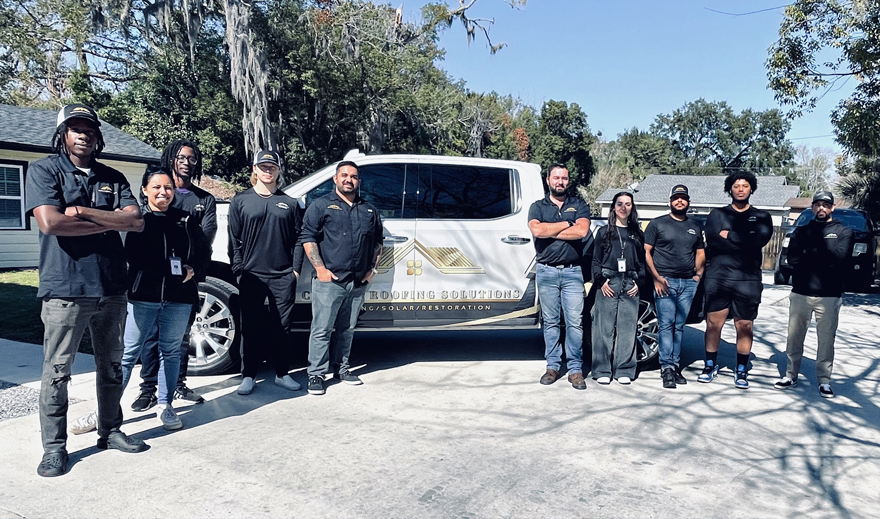
CALL TODAY AT (904) 808-3550
At Custom Roof Solutions, we understand Jacksonville’s unique weather conditions and architectural styles. Whether it’s protecting your home from hurricane-force winds, foof repairs or enhancing its curb appeal with a modern design, our experienced team delivers superior results and ensures long-lasting durability with our premium materials.
